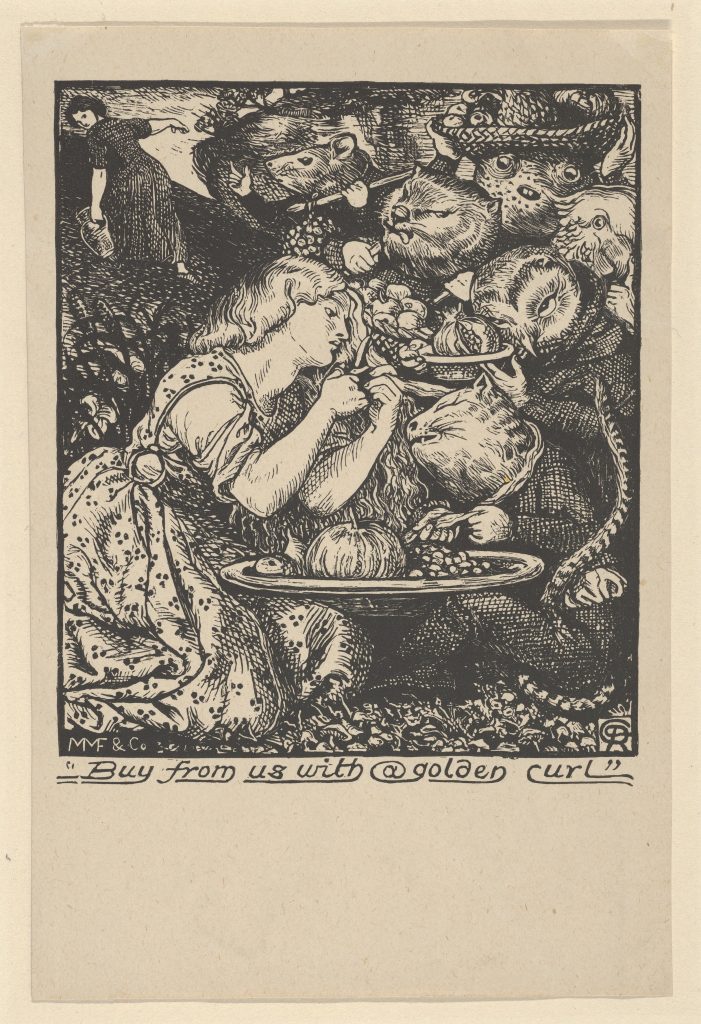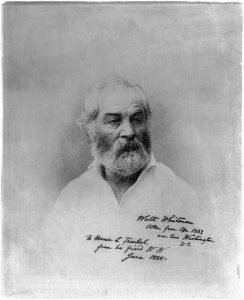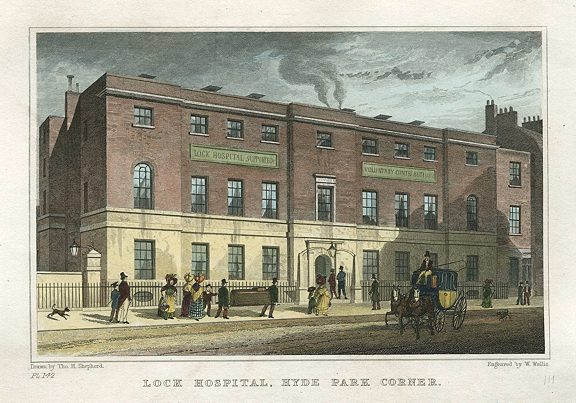Before Christmas I checked out a book from my little public library branch: Naomi Wolf’s Outrages: Sex, Censorship, and the Criminalization of Love. I had a lot of other things to read and left it for last, not knowing what it contained, vaguely recognizing the author’s name. Turning to it, I recognized Wolf’s photo. If nothing else, readers might remember her defense of Julian Assange when he was accused of sex crimes in Sweden. I thought the book would be a history of censorship, but it’s more comprehensive. By introducing and then returning often to her cast of characters, Wolf creates an intimate narrative against the mise en scène of her historical sweep and sociopolitical stance.
Outrages, published last year, begins with a poem written by John Addington Symonds (1840–1893) to a fellow student while at an Oxford school beginning in 1859.1 I’d come across Symonds’s writings decades ago. He was a poet and critic, an Italophile and homophile. Wolf came across his manuscript of the poem—to a male W.—and found its pages literally cut out and re-placed. That Symonds felt it necessary to bowdlerize his own ode is at the heart of Wolf’s book, which she calls, as indicated, “the criminalization of love.” A change in British law made such an artifact, titled “In Memoriam Arcadie,” an item of incrimination.
Symonds penned the poem in remembrance of Arcadie (aka Arkady)—the domicile of pastoral Pan, the Greek god of wildness (including fleshly felicities)—and in memoriam “for a lost love, and a lost paradise.”2 But Symonds may as well have conferred upon his verse a moniker mourning the passing of the Napoleonic Code, which allowed homosexual acts (by omission). Wolf chronicles how British law moved from looking the other way to looky-loo to lock-’em-up for four decades prior to the arrest of Oscar Wilde in 1895. Drawing on others’ as well as her own confirmatory research she argues that Wilde’s was not the “defining moment” of prosecution. Rather, his two-year penalty was but the most famous of a “lost history” of “far longer sentences at hard labor for sodomy, penal servitude for life, and even executions […] meted out to men who loved men, and even to young boys,” an “escalation” that began by 1857, two years before Symonds began his rhymes.3

Yet, just a few years after “Arcadie,” Symonds went on to write his famous essay, A Problem in Greek Ethics, eventually committing it to print privately in a 1883 edition of ten copies (omitting the name of author and publisher). A Johns Hopkins University introduction to Symonds states that his Problem is “one of the first major modern studies of Ancient Greek sexuality.” JHU’s Shane Butler, a Professor of Classics, discusses the many incarnations of Symonds’s Problem. He explains that Symonds died before the essay had its public debut in 1896 via sexologist (and eugenicist) Havelock Ellis—but it was in German and under the less veiled title “Die Homosexualität in Griechland” (Homosexuality in Greece). Lest that raise eyebrows, the essay was somewhat buried as Chapter 3 of a volume with the more euphemistic title Das konträre Geschlechtsgefühl (Contrary Sexual Feeling), yet the book was billed as a collaboration between Symonds and Ellis.
The next year, 1897, the konträre Geschlechtsgefühl (in German) became something less loose—Sexual Inversion (in English).4 But with this, mm…, outing Ellis demoted Symonds’s essay from Chapter 3 to the Appendix while retaining him as coauthor on the title page of what was to be the first in a series by Ellis on the psychology of sex, as Prof. Butler notes. Due to a protest by Symonds’s family, Ellis dropped both Symonds’s essay and byline from a second edition of Sexual Inversion. Meddling aside, Butler shows how Problem subsequently had a life of its own, sometimes being paired with Symonds’s A Problem in Modern Ethics (1891), as it is in my own copy.5 The latter essay “brought the word homosexual, recently coined in German, into English-language print for the very first time,” according to the JHU introduction to Symonds.
Stellar Stumble
Having spent a lot of time in bookstores myself looking for items of a niche appeal, I don’t have to imagine the delight experienced by librarian Gabrielle Dean when late last year she stumbled upon what is thought to be only the sixth extant copy of Symonds’s little dry run. Dean is William Kurrelmeyer Curator of Rare Books and Manuscripts at JHU’s Sheridan Libraries. The item, at an antiquarian seller’s website, also included two letters: the first a one-page presentation missive to Sir Richard Francis Burton, whom Symonds had met; the second, Burton’s four-page reply.
The book and bonus were listed by at least mid October, asking price: $45,000. Time to check the Sheridan’s accessions fund balance. To think that it might slip into a private collection…
Academic Exercises
To say that Dean stumbled upon the Symonds listing is no distortion. She wasn’t looking for the book at all but rather was searching the web for examples of his handwriting to confirm an inscription in another of his books. And that task was in the course of preparing an exhibition at JHU to be, mm…, mounted by the school’s John Addington Symonds Project, which is nourished by both Dean and Shane Butler. The exhibition hauls Symonds from the 19th century to the 21st via the now-obligatory Q-word under the title Queer Connections: The Library of John Addington Symonds, which still is on display through March 13 of this year.
This sixth copy of A Problem in Greek Ethics surely is the exhibition’s centerpiece. Having been loaned to Burton and then returned, it became one volume of Symonds’s library, which to a large extent was broken up after his death. One of the Symonds Project ventures is to reassemble the contents of its namesake’s shelves, virtually of course. An academic exercise? The Project explains that because Symonds relocated to Davos, Switzerland in 1880 he had no easy access to libraries other than the one he’d assembled via his own purchases and gifts. Symonds was a Classical scholar, this scholarship intersecting with sexuality. So his library could be a snapshot in time, perhaps anticipating Magnus Hirschfeld’s collections at the Institut für Sexualwissenschaft in Berlin in the 1920s and ’30s.
Four items on display are highlighted in a Symonds Project news item. That these include a (rare) copy of Das konträre Geschlechtsgefühl as well as two early editions of Leaves of Grass by Walt Whitman (with whom Symonds corresponded) comes as no surprise. But also displayed is a “first edition of Robert Louis Stevenson’s Strange Case of Dr. Jekyll and Mr. Hyde (1886), which Stevenson partly modeled on Symonds, whom he had met and befriended in Davos.”
A more long-term task taken on by the Symonds Project is an online edition of that 1897 version of A Problem in Greek Ethics, i.e. Appendix A of Sexual Inversion. This still is under construction, but the text is there, and links point to the original Greek sources (in English) for context. Per the Project’s introduction the online edition eventually will contain an index as well as annotations. The original 1883 version will receive the same treatment later on.
To get a sense of why academics would want to study Symonds and his studies in the first place, see the Symonds Project Student Blog. At the very least it demonstrates at a glance the breadth of the man’s interests.
P-words
While I was writing this, The Intercept’s Voices platform hosted author Judith Levine, perhaps best known for her Harmful to Minors: The Perils of Protecting Children from Sex (Minneapolis: University of Minnesota Press, 2002). In her February 16 article Levine profiles beleaguered classics professor Thomas K. Hubbard of the University of Texas Austin, who has been hounded from his work and home by critics—not for having committed an act but rather for holding a view informed by his knowledge of Greek culture and customs (of a given socioeconomic class, of course). Hubbard, who “opposes unlawful activity,” has suggested that Greek pederasty could “be a model for thinking about current ages of consent,” as Levine puts it. Levine doesn’t flipflop in her article as much as she sympathizes with Hubbard when she isn’t criticizing him. Read it and see what you think, but I raise it not for its polemics (cf. Milo Yiannopoulos) but rather for a few lines in which Levine echoes Naomi Wolf’s Outrages.
We naturalize our revulsion against such desire [pedophilia]. But, as Hubbard’s work shows, sexual mores are shaped by history and culture. For instance, the same 1885 law that raised Britain’s age of consent only for girls from 13 to 16 also criminalized “gross indecencies,” or homosexual acts between adult men.
But this damage was done nearly three decades earlier by the Matrimonial Causes Act of 1857: “a man could divorce his adulterous wife, plain and simple; but a heterosexual man could be divorced by his wife only if he committed various arcane, very strenuous, or rare sexual and emotional misdeeds,” Wolf writes, which boiled down to “rape or sodomy or bestiality.”6 And so married-male indiscretion was reined in somewhat while throwing women a small bone.
Despite sodomy being punishable by death, the reason its practitioners largely had escaped that fate was that they’d been tried by juries reluctant to go that far. The Criminal Justice Act of 1855 would change this, allowing judges to issue harsh summary convictions. That in turn was tempered in 1857 by the Penal Servitude Act, which changed the penalty for sodomy to, well, penal servitude, its tortures being enumerated by Wolf.7 (Such a “reform” should remind us that our own prison system resulted in part by efforts of supposedly well-intentioned Quakers.8)
Wolf explains that in those four decades after 1857 “public attention was successfully directed away from a surprisingly widespread feminist confrontation with heterosexual male privilege and toward these ‘sexual outsiders’”: the homosexuals. This spotlight-shining “slowed the initially successful effort by angry women to start policing the sexuality of heterosexual men.” She claims that this “reoriented British society.”9
Libertine v. Victorian?
Wolf goes on to contrast poets Walt Whitman, whom Symonds knew via correspondence, with Christina Rossetti (1830–1894), whom he knew by reputation; she and her brothers were associated with the Pre-Raphaelites avant garde. (I was introduced to Rossetti by my friend Milania, a reader of this blog.) This comparison is more complex than, say, libertine and Victorian. For instance, Wolf places Whitman’s “Song of Myself” with its “rapturous descriptions of ripe, red fruit”—for the sucking, no less—alongside Rossetti’s “I Know You Not”—just as erotic but addressed to “the safer figure of Jesus,” for whom she thirsts “full Fount and Flood,” his “Vine” being “sweeter than clustered grapes.”10 Symonds was much taken with Whitman’s work, but Wolf argues why it could have troubled women like Rossetti, who surely had known Leaves of Grass through her brother William Michael. Christina, Wolf writes, “had witnessed, within her own family circle, the social vulnerability of sexually compromised women,” and goes on to describe it.11 “Perhaps in reaction to this appalling drama, with its waste of human life and potential,” writes Wolf, Rossetti began to volunteer with women sex workers who wanted a way out. It’s to these women that the poet wrote “Goblin Market,” her most famous poem, “to read it to the prostituted women whom she was assisting.”12 The poem is an allegory, again involving fruit (and sucking), bittersweet, yet ending with “life out of death,” a story to be passed down the generations.13 14

What Wolf doesn’t mention (at least in the first hundred of her pages that I’ve read) is that when “Goblin Market” was published in 1862 Whitman himself had a reaction to an appalling drama that impacted his own family circle. From a Whitman chronology:
1861–62
At outbreak of Civil War vows to live a ‘purged’ and ‘cleansed’ life. Writes freelance journalism; visits the sick, injured, and wounded at New York Hospital. Goes to the war front in Virginia (December 1862) when he learns his brother George has been wounded.15
(Flipping ahead in Wolf’s book I see she does discuss the above, as well as the fact that Christina Rossetti’s brother William Michael was involved in an 1868 expurgated edition of Whitman’s poetry. I knew I might regret writing this post prior to completing Wolf’s book…)

Lock Hospitals and the Unfortunate Rake
Wolf ends her first hundred pages with a chapter titled The State Seizes the Female Body.16 She tells in much detail about the consequences of women to whom I’d been introduced about twenty years ago (about which more below). Wolf explains how Christina Rossetti’s cautionary Goblin tale wasn’t necessarily “defensive or even reactionary” when compared with peers who fought against sexual double standards. Sexual temptation could lead to venereal disease, codes for which Britain had imported from its colonies, codified as the four Contagious Diseases Acts. To protect the public, suspect women could be snagged; say, “factory girls walking home from a late shift after dark,” unaccompanied women out for a drink, women accompanied by a man, even a relative, women who “looked too sexually experienced.” A magistrate convinced of a woman’s profession could submit her for vaginal examination, by unsanitized, easily contaminated specula. (Earlier Wolf, in her chapter The War Against “Filth,” shows how infection that was spread by sewage led to efforts in “cleaning up the commons,” efforts that would expand, as one can imagine.17) Examinations that proved positive caused women to be sent to “lock hospitals” for up to a year. Eventually the public, initially supportive, began to protest the roundups of these women, some of whom were known to be “respectable.” But not before many had undergone treatments involving rubs of mercury paste that would cause symptoms like intense salivation. As I read Wolf’s words, I already knew some of this—from an old-time-music band based in San Francisco, The Crooked Jades.

About twenty years ago The Crooked Jades issued their second and third albums under the title The Unfortunate Rake. Coyly, the title song wasn’t included on Volume One. In the liner notes for Vol. 2, Jades’ founder Jeff Kazor talks of a 19th-century UK “Rake Ballad cycle,” without defining the R-word, which is worth doing. It’s short for rakehell, defined as “a licentious or dissolute man.” I guess it’s a guy who raises hell, but by scratching or scraping. Kazor:
Later the gender was changed to female and became known as “The Bad Girl’s Lament.” Ointments of metallic mercury were used in past times as a cure for syphilis, and one of the results of such curative attempts was an excessive flow of saliva on the part of the patient: “salivation.”
A remarkable turn of phrase for a cure that killed, as told by Wolf.
Rather than summarize, because all of this strikes me as having little closure, I’ll offer the Jades’ rendition of such a rake ballad, traditional words set to Kazor’s plaintive tune and the band’s delicious picking. If it recalls for you any stateside cousins, as it does for me, indeed it is related to the “Cowboy’s Lament” aka “Streets of Loredo,” and “St. James Infirmary Blues.”
Coda
I’m struck by the similarity between the portrait above of Mary Fisher by Julia Margaret Cameron, which The Crooked Jades used for their third album, and the likeness of Christina Rossetti below.

And in light of my writing in November about the photography of Lewis Carroll I’ll mention that Carroll took portraits of Christina Rossetti and members of her family in 1863.
Notes
- Naomi Wolf, Outrages: Sex, Censorship, and the Criminalization of Love (Boston New York: Houghton Mifflin Harcourt, 2019), 3.
- Wolf, xiv. The name was appropriated by a French homophile organization, which began publishing Arcadie: Revue Littéraire et Scientifique in January 1954. See “ARCADIE—In France!”, ONE magazine, Vol. 3, No. 1 (Jan 1955), 39; archived here.
- Wolf, 63, 62.
- My copy of Symonds’s essay, referenced below, states that “sexual inversion” was Symonds’s term, not Ellis’s (p. 3).
- To make matters confusing, my copy, containing both “Problem”s, is titled Sexual Inversion: A Classic Study of Homosexuality (New York: Bell, 1985); it’s a reprint of a book published privately in 1928 under the title Studies in Sexual Inversion. I’m grateful to Prof. Butler for his article’s disambiguation.
- Wolf, 53.
- Wolf, 60–61.
- See the chapter Imprisonment and Reform in Angela Davis, Are Prisons Obsolete? (New York: Seven Stories Press, 2003). For an investigation of the Protestant underpinnings of modern mortification see T. Richard Snyder, The Protestant Ethic and the Spirit of Punishment (Grand Rapids: Wm. B. Eerdmans, 2001).
- Wolf, 62.
- Wolf, 92–93.
- Wolf, 93–95.
- Wolf, 95.
- In the spirit of Rossetti’s characters’ retelling Rossetti’s fiction, see Dinah Roe’s “An introduction to ‘Goblin Market'” at The British Library, which takes the reader from “a fairytale world” to an astonishing opening of “the floodgates for Feminist, Marxist, Freudian, Queer Theory and New Historicist critiques” beginning with Playboy Magazine. You really need to see Roe’s list by scrolling to the last section, Interpretations.
- I disagree with Wolf’s interpretation of the “Goblin Market” frontispiece, pictured above. To riff off an apocryphal Freudism: sometimes a rat’s ‘‘phallus-shaped staff’’ is just a shoulder yoke. Wolf also IDs the creature at top right as frog-like, its spots suggesting “the lesions of venereal disease.” But biographer Mackenzie Bell quotes Christina Rossetti’s brother William Michael: “Between wombat and cockatoo comes a speckled animal […]: it is a sunfish which belonged to my brother,” Dante Gabriel, from whose original the frontispiece was engraved. (See this 1802 rendering of a sunfish, aka opah or kingfish.) Wolf also misidentifies the figure at top left as the poem’s Lizzie, somehow ignoring Dante Gabriel’s illustration, “Golden head by golden head,” which faced that frontispiece in Christina’s 1865 collection and which depicts Lizzie and her sister Laura. Wolf doesn’t sufficiently convey the two Rossettis’ collaboration on the illustrations, stating that the erotic quality of Dante Gabriel’s imagery “was already well-known, and controversial,” thus Christina “understood exactly what she was commissioning,” and that she “openly approved” the illustrations’ “sexual content,” such approval being conveyed by “her stylized ‘CR’ logo [that] is embedded in the corner of the woodcuts.” But that “logo” is Dante Gabriel Rossetti’s own “DGR” monogram, included in many of his works, including this drawing from 1870. (See Christina’s own signature here.) Further, Christina’s brother William Michael told biographer Bell that it was Christina herself “who says what the Goblins were like—wombat, ratel, etc., etc.” and Dante Gabriel who executed them.
- Justin Kaplan, Chronology, included in Walt Whitman: Complete Poetry and Collected Prose (New York: Literary Classics of the United States, 1982), 1349.
- Wolf, 102–107.
- Wolf, 41–47.

